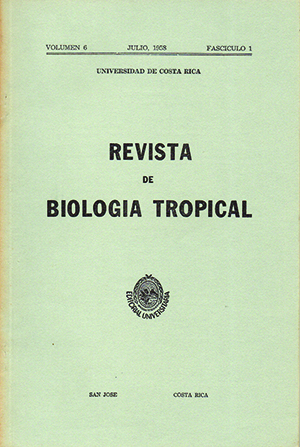Abstract
Three species of the genus Ooehoristiea Lühe, 1898, are re-described: O. antrozoi Voge, 1954, found in a "toloque" lizard from the state of Tabasco, Mexico. O. eumecis Harwood, 1932, collected in an iguana from Alpuyeca, state of Morelos, Mexico. O. pennsylvanica Chandler & Melvin, 1951, from the oppossum Didelphis marsupialis etensís Allen, Bello Horizonte, Escazú, San José, Costa Rica. The number of described species of Oochoristíca has increased greatly since the genus was proposed in 1 898. Many of these descriptions have been based on characters of little or no significance, resulting in abundant synonymy. Our revision of the literature and our observations lead us to acknowledge with DELLA SANTA (9), some sixty valid species to date. After reviewing the works of BAYLIS (2), MEGGIT (24), HSÜ (18), STUNKARD & LYNCH (27), DOLLFUS (10, 11, 12), the following characters are proposed as critical in the study of species of Oochoristica. I. Morphology of the mature proglottid, with: 1) Morphology, size, and number of testes. 2) Position of these organs. 3) Shape, size and position of the cirrus pouch. 4) Morphology of cirrus. 5) Position of genital atrium and histology of the same. 6) Morphology and constitution of the ovary as well as transversal diameter of the same. 7) Morphology and constitution of the vitelline gland as well as the transversal diameter of this gland. 8) Morphology and constitution of the seminal receptacle. 9) Distribution and arrangement o f the excretory ducts. II. Morphology and size of the gravid segments, with: 1) Development of the uterine capsules. 2) Position and number of the capsules as well as its morphology. 3) Morphology and size of the ova. III. Morphology of the scolex, with: 1) Shape and constitution of the suckers, size of these organs. 2) Transverse diameter of the scolex, at the level o f the suckers. The measurements should be taken very carefully, because they can be used in certain ratios, as DELLA SANTA states, which indicate the degree of maturity of the organs and the segment. Certainly these measurements represent approximative data if they are taken as "absolute", and they will have a value only when there are many specimens to work with. Then the following criteria, should be added to the characters listed above: IV. Ratio of the transversal diameter of the suckers to the diameter of the scolex. V. Ratio of the length of the cirrus pouch to the with of ripe segments. VI. Ratio of the transversal diameter of the ovary to the with of ripe segments. These ratios are usefull in the estimation of the variability of the organs, which has originated much confusion in the establishment of new species.
Comments
Downloads
Download data is not yet available.






